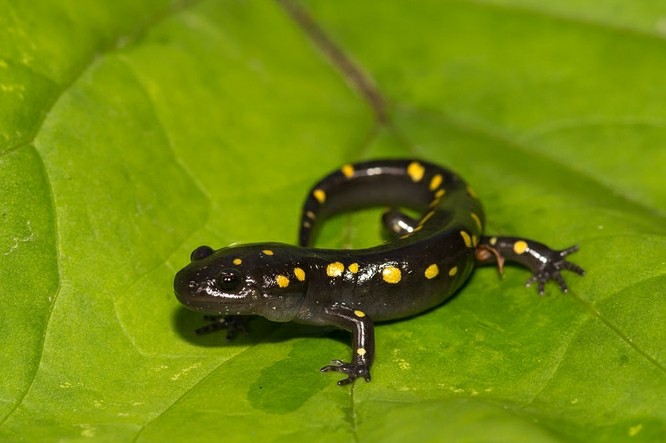Salamanders are quiet, secretive amphibians that many people rarely see. But if you are lucky enough to find one, it’s natural to wonder how you should act.
If you find a salamander, it’s best to watch it without disturbing its home, avoid handling unless necessary, and if moved, return it safely to a nearby moist area.
Why Are Salamanders Sensitive?
Salamanders have thin, moist skin that is very delicate. Their skin helps them breathe. Unlike mammals, salamanders don’t rely mainly on lungs.

Many breathe partly through their skin by absorbing oxygen from air or water. Their skin must stay wet and clean for this.
Because their skin is fragile, rough handling or contact with chemicals can harm them. Oils, lotions, soap, or dirt on your hands can make them sick or cause death.
Some salamanders also produce mild toxins on their skin secretions to deter predators. These toxins are usually harmless to people but can irritate eyes or cuts.
This is why you should handle salamanders gently and with care.
Should You Pick Up a Salamander?
If you see a salamander in the wild, it’s best to watch quietly from a distance. Salamanders are shy and easily scared. Sudden moves or grabbing can stress or hurt them.

Sometimes you might need to move a salamander to keep it safe, such as if it’s in a road or near danger.
If so, follow these steps:
- Wash your hands with clean water first. Avoid soaps or chemicals.
- Use wet hands or damp gloves to keep the salamander’s skin moist.
- Gently scoop the salamander from underneath, supporting its body. Don’t squeeze.
- Hold it low to the ground to prevent injury if it slips.
- Return it to a safe, moist place nearby, such as under leaves, logs, or near water.
- Keep handling time brief to reduce stress.
Never take wild salamanders home as pets or remove their eggs.
How Can You Safely Observe Salamanders?
Salamanders are interesting to watch, especially at night or when it is wet. To enjoy watching without harm:
- Visit known salamander habitats like forests, streams, ponds, or wetlands during cool, damp weather.
- Use a flashlight with a red filter or dim light at night so you don’t scare them.
- Stay quiet and move slowly.
- Take photos without flash or loud sounds.
- Don’t turn over logs or rocks unless necessary.
- Avoid stepping on plants or disturbing their home.
Watching salamanders behave naturally can be rewarding and helps you appreciate their role in ecosystems.
What Kind of Habitat Do Salamanders Need?
Salamanders live in moist places that offer shade and clean water. These include forests with thick leaf litter, wetlands, vernal pools, cool streams, and ponds. They spend much time hiding under logs, rocks, or soil where it is damp and cool.
Because salamanders breathe through their skin and lay eggs in water or moist places, their habitat must stay wet and clean.
What Should You Do If You Find a Salamander Inside Your House?
Sometimes salamanders wander into homes looking for moisture or shelter, especially during rain or warm weather. Finding one inside can be surprising but is usually harmless.
If you find a salamander indoors:
- Gently catch it with wet hands or a soft container.
- Don’t squeeze or drop it.
- Release it outside as soon as possible near a moist area like a garden, woods, or pond.
- Seal cracks or openings where salamanders could enter.
- Keep basements, crawl spaces, and foundation areas dry and well-ventilated.
- Don’t use poisons, traps, or pesticides inside or near your home.
Salamanders inside usually want moisture and will not harm you.
Can You Keep a Salamander as a Pet?
Some people keep salamanders as pets, but it needs special care. Wild salamanders should never be taken from nature. Doing so harms populations and can spread disease.

If you want a pet salamander, buy one from a responsible breeder or pet store. Learn about:
- Tank size and setup.
- Temperature and humidity needs.
- Proper diet.
- Regular cleaning and care.
Good care helps pet salamanders stay healthy and happy.
What to Do If You Find Salamander Eggs
Salamanders lay eggs in water or moist places, often in jelly-like clusters on plants or rocks. These eggs are very fragile and dry out quickly if disturbed.
If you find eggs:
- Don’t move or touch them.
- Keep the area moist and shaded.
- Avoid disturbing breeding sites.
- Watch quietly from a distance.
Protecting eggs helps salamanders reproduce.
When to Report Salamander Sightings or Concerns
Some groups track salamanders and need reports to understand their health.
Report if you see:
- Many dead or sick salamanders.
- Salamanders outside their usual areas.
- Unusual behaviors or injuries.
Include location, date, time, and photos if possible.
Conclusion
Finding a salamander is a special experience that connects us to nature’s hidden world.
The best way to help is to watch quietly, handle carefully only when needed, and protect the habitats they depend on.
Whether you find a salamander outdoors or inside your home, respecting these creatures supports their survival and enriches our environment.
Hi, my name is Ezra Mushala, i have been interested animals all my life. I am the main author and editor here at snakeinformer.com.

